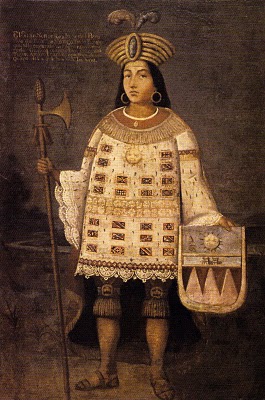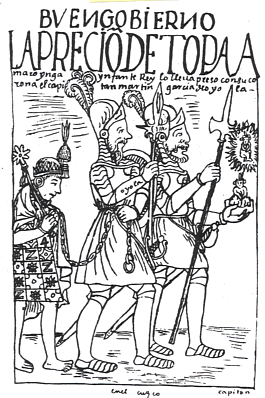Túpac Amaru facts for kids
Quick facts for kids Thupaq Amaru |
|
|---|---|

Tupac Amaru, the last Sapa Inca of Vilcabamba
|
|
| Sapa Inca of the Neo-Inca State | |
| Reign | 1571–1572 |
| Predecessor | Titu Cusi |
| Successor | State abolished Juan Santos Atahualpa [as self-proclaimed Sapa Inca of a (neo-)Inca Empire] |
| Born | April 14, 1545 Peru |
| Died | September 24, 1572 (aged 27) Cusco, Viceroyalty of Peru, modern-day Peru |
| Quechua | Tupaq Amaru |
| Dynasty | Hanan Qusqu |
| Father | Manco Inca Yupanqui |
Tupaq Amaru (born April 14, 1545 – died September 24, 1572) was the very last Sapa Inca (which means "only Inca" or emperor) of the Neo-Inca State. This was the last part of the Inca Empire that remained free from Spanish rule. He was captured and executed by the Spanish after they took over the Neo-Inca State.
His name comes from the Quechua words thupaq, meaning "royal" or "shining." The word amaru can mean "snake" or refers to a snake-like creature from old Andean stories.
Contents
Becoming the Inca Leader
After the Spanish conquest of Peru in the 1530s, some members of the Inca royal family created a small, independent state. This was the Neo-Inca State in a place called Vilcabamba. It was hidden away in the Upper Amazon region, northeast of Cusco.
The founder of this state was Manco Inca Yupanqui. He first worked with the Spanish but then fought against them. He settled in Vilcabamba in 1540. In 1544, the Spanish attacked, and Manco Inca Yupanqui was killed.
His son, Sayri Tupac, became the next Sapa Inca. He later agreed to Spanish rule in 1558 and moved to Cuzco. He died in 1561. His brother, Titu Cusi, then became the leader in Vilcabamba. Titu Cusi died in 1571. After his death, Túpac Amaru, who was another brother, became the new Sapa Inca in Vilcabamba.
The Final Battle and Capture
At this time, the Spanish didn't know that Titu Cusi had died. They sent two messengers to continue talks with him. Sadly, an Inca captain killed both messengers at the border.
The new Spanish viceroy, Francisco de Toledo, Count of Oropesa, used this as a reason to attack Vilcabamba. He said the Incas had broken important rules about treating messengers. He declared war on April 14, 1572.
The first fight happened in the Vilcabamba valley on June 1. The Inca people fought bravely, even though they had light weapons. They tried many times to break the Spanish attack, but they had to retreat each time. On June 24, the Spanish entered Vilcabamba. They found the city empty and the Sapa Inca gone. The city was destroyed, and the Neo-Inca State officially ended.
Túpac Amaru had left the day before with about 100 people. They went west into the lowland forests. His group, which included his generals and family, split up to avoid being caught.
Three groups of Spanish soldiers chased them. One group captured Titu Cusi's son and wife. Another group returned with prisoners and valuable items like gold and silver. The third group brought back Túpac Amaru's two brothers and other relatives. But the Sapa Inca and his main commander were still free.
Then, a group of forty special Spanish soldiers, led by Martín García Óñez de Loyola, went after them. They followed the Masahuay river for a long way. They found an Inca storage place with gold and the Inca's dishes. The Spanish captured some local people and made them say what they had seen. They learned that the Sapa Inca had gone down the river by boat to a place called Momorí. The Spanish then built five rafts and followed.
At Momorí, they found that Tupac Amaru had left by land. With help from local guides, they followed his path. They learned that Túpac was moving slowly because his wife was about to have a baby. After a long march, they saw a campfire at night. They found Túpac Amaru and his wife warming themselves. The Spanish promised they would not harm them, and Túpac Amaru surrendered. He was then arrested.
The captured Incas were brought back to the ruins of Vilcabamba. On September 21, they were all marched into Cuzco. The Spanish also brought the preserved remains of Manco Cápac and Titu Cusi. They also brought a gold statue of Punchao, which represented the Inca family line and held the hearts of dead Inca kings. These sacred items were then destroyed.
A Sad End: His Execution
The five captured Inca generals had a quick trial and were sentenced to death by hanging. Some had already died from torture or illness.
The trial of the Sapa Inca began a few days later. Túpac Amaru was found guilty of killing priests in Vilcabamba. He was sentenced to be beheaded. Many Catholic priests believed Túpac Amaru was innocent. They begged the Spanish to send him to Spain for a trial instead of executing him, but it didn't help.
Many people have said that Viceroy Toledo, by executing a leader the Spanish saw as an independent king, went too far. They believed he committed a crime for his time. Others argued that Túpac Amaru was rebelling, that Toledo had tried to make peace, and that Inca soldiers had killed three of his messengers. Also, Túpac Amaru had gathered an army to fight the Spanish. The King of Spain, Philip II, did not approve of the execution.
An eyewitness said that on the day of his execution, Túpac Amaru rode a mule. His hands were tied behind his back, and a rope was around his neck. Other witnesses said there were huge crowds. The Sapa Inca was surrounded by hundreds of guards with spears. A scaffold covered in black cloth was set up in the main square of Cuzco, in front of the Cathedral of Santo Domingo. About 10,000 to 15,000 people were there to watch.
Túpac Amaru went up onto the scaffold with the Bishop of Cuzco. As he did, witnesses reported that "a huge crowd of Indians, who completely filled the square, saw that sad sight. They knew their lord and Inca was going to die, and they filled the sky with their cries and wailing."
Eyewitnesses Baltasar de Ocampa and Friar Gabriel de Oviedo said that the Sapa Inca raised his hand to quiet the crowds. His last words were: "Ccollanan Pachacamac ricuy auccacunac yawarniy hichascancuta." This means, "Pacha Kamaq, witness how my enemies shed my blood."
His Lasting Legacy
Almost forty years after the Spanish conquest of Peru began with the execution of Atahualpa, it ended with the execution of his nephew, Túpac Amaru I. The Spanish Viceroy gathered the royal family members. Many of them, including Túpac Amaru's three-year-old son, were sent away to places like Mexico, Chile, and Panama. Some were later allowed to return home.
Túpac Amaru's memory lived on. He became a symbol for an important uprising in the late 1700s. This rebellion wanted to bring back Inca power against the Spanish government. In 1780, José Gabriel Condorcanqui, who said he was a direct descendant of Túpac Amaru, led a native uprising in Peru. His wife, Micaela Bastidas, also helped. Condorcanqui's rebellion started because the Spanish crown put new rules and taxes on the native people. Túpac Amaru II's rebellion began when he captured a Spanish official, Antonio Arriaga, in November 1780.
Historian El Inca Garcilaso De La Vega said that King Philip II did not like the public execution of Tupac Amaru. Tupac Amaru's death in 1572 has been remembered for centuries.
Not much is known about Tupac Amaru, but his death became a symbol of strength in the region. Public figures like Jose Gabriel Condorcanqui were inspired by Tupac Amaru's ideas. He even changed his name to Tupac Amaru II. Even though Tupac Amaru had a short and sad life, his legacy is very important, especially among the people of Peru.
A primary school in Warsaw, Poland, was named in honor of Túpac Amaru, but it closed in 2001. The famous rapper Tupac Amaru Shakur was named after Túpac Amaru II.
See also
 In Spanish: Túpac Amaru I para niños
In Spanish: Túpac Amaru I para niños
- Amaru (mythology)
- Neo-Inca State
- Vilcabamba
- Manco Inca Yupanqui
- Sayri Tupac


